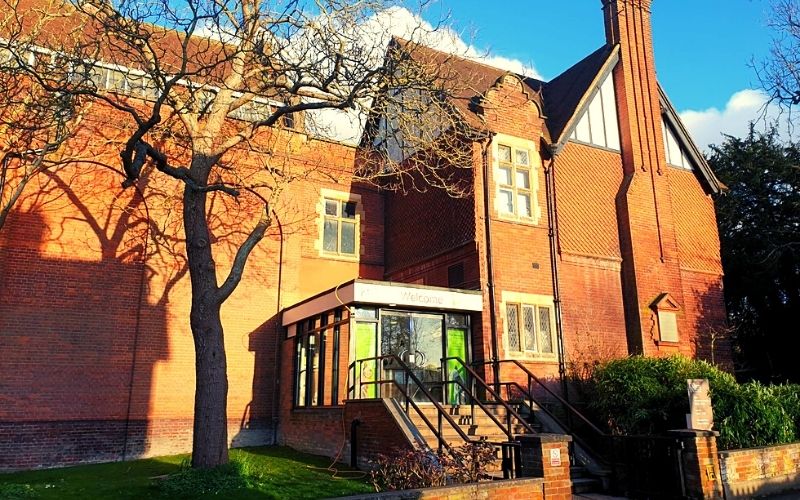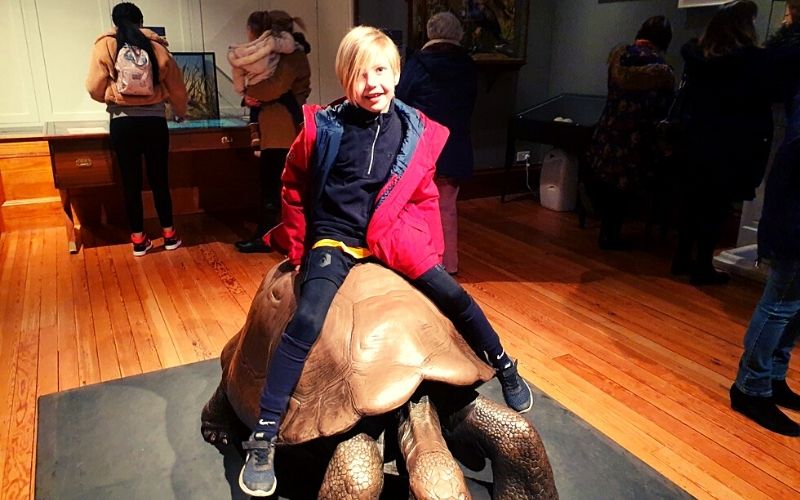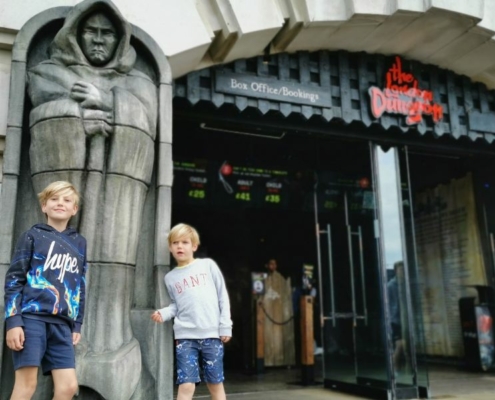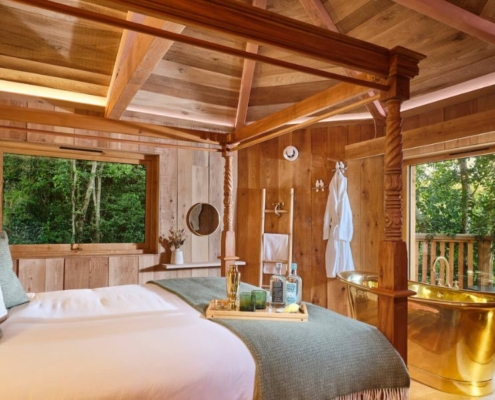The Tring Natural History Museum: A Complete Visitor’s Guide
Just a little way out of London in the Hertfordshire town of Tring you can find the Tring Natural History Museum. It’s tucked away on the edge of the town in a quiet and relatively unassuming building (compared to the grandeur of the Natural History Museum in London).
We hadn’t given it much thought because there was no way it could compare to the London Natural History Museum (one of the best museums in London for kids and one of the most visited London attractions with kids)… or could it?
This post contains affiliate links. If you click on one and book or buy something, we may earn a small commission but this is at no extra cost to you.

The Tring Natural History Museum
Having visited the London Natural History Museum many times (the most visited museum in Europe with over 5 million visits a year), we didn’t think it would be worth visiting such a small museum that would pale in comparison.
Finally, on a cold February day when the grandparents were staying with us, we decided to give it a go. How wrong we were not to have visited before.
This museum is an absolute gem and it’s a shame we didn’t visit the Tring Museum when the kids were younger. All those days enduring soft play when the weather was bad and this was just down the road the entire time!
We all had an amazing time and can highly recommend visiting the Tring Natural History Museum with kids. Here’s a little information on the museum and on our visit to help you plan your own visit.
Where is the Tring Natural History Museum?
The Tring Natural History Museum is located in the town of Tring about 40 miles (70 km) north-west of London.
Tring itself is a lovely small town and if you have more time (and are looking for family days out from London), we would highly recommend spending the day there. See here for a gorgeous TreasureMapTrail of Tring which is perfect for kids.
It is right on the edge of the Chiltern Hills, an Area of Outstanding Natural Beauty, which is a lovely location to take a family walk, particularly Wendover Woods, Dunstable Downs and Ashridge Estate, home to one of the loveliest bluebell woods in Hertfordshire.
Read more: The Best Family-Friendly Walks In Hertfordshire and Christmas Events in Hertfordshire
The Walter Rothschild Building
Akeman Street
Tring
Hertfordshire
HP23 6AP
Getting to the Natural History Museum
By Train
Using the London Northwestern Railway, you can reach Tring station in around 40 minutes from London Euston station. The station is about 2 miles from the museum so you’ll need to take a taxi or bus number 387 towards New Mill. Tring is a great option if you are looking for days out from London by train.
By Car
Tring is located about 40 miles north of London and can be reached by taking the M1 north (exiting at Junction 8) and then the A41.
One of the advantages of visiting the Tring museum over the London Natural History Museum is that there is a small on-site car park.

Back entrance to the Tring Natural History Museum
Natural History Museum Tring Opening Times
The museum is open daily from 10 am to 5 pm from Monday to Saturday and 2 pm to 5 pm on Sundays and it is free to visit (although a donation to keep these incredible facilities open is highly recommended).
The History of the Natural History Museum at Tring
The museum started as the private collection of Lionel Walter Rothschild, the 2nd Baron Rothschild, and opened to the public in 1892. He had a penchant for zebras but it didn’t stop there.
He went on many expeditions all over the world and amassed the greatest private natural history collection in the world. When he died in 1937, he left his entire collection to the Natural History Museum in London.
Today it has one of the finest collections of stuffed animals in the United Kingdom with over 4000 specimens. These days it is under the control of the Natural History Museum and has many striking similarities to the more famous relative.

Big cats at the Tring Natural History Museum
So why visit the Tring Natural History Museum?
Obviously, the Natural History Museum at Tring doesn’t have room to suspend a blue whale skeleton from the roof of the entrance hall, but it is like the Dr Who Tardis. There are 6 main galleries over 4 floors with a very impressive selection of exhibits.
The main reason to visit the Tring Museum is that it’s much less busy than the London Natural History Museum without massive queues to get in.
We’re not saying that you shouldn’t visit the Natural History Museum in London (which is one of the best free things to do in London with kids). We’re just saying that there is a fantastic alternative not a million miles from London that is well worth a visit if you don’t like crowds.
It is run by the London Natural History Museum and so, once inside, there are many similarities but just on a smaller scale.

Beautiful butterflies at the Tring Natural History Museum
The Galleries at the Natural History Museum in Tring
To give you a good idea of what is where at the museum, you can take a look at the museum map.
Gallery 1
Polar bear, big cats and other mammals all displayed in beautiful, original Victorian glass cabinets in Gallery 1.

Polar Bear in Gallery 1 at the Tring Museum
Gallery 2
Gallery 2 is a temporary exhibition space and houses exhibits like mummified Egyptian animals. Check on the museum website to see what they are running as the exhibits change from time to time.

Insects on display at the Tring Natural History Museum
Gallery 3
From sharks suspended from the ceiling to elephant and rhinoceros, there are certainly some large mammals to view here. You won’t miss the prehistoric-looking skeleton of the giant sloth as you first enter this gallery as it is enormous.
In contrast to these huge animals, check the small cabinets at the far ends of the gallery for all sorts of insects.
Don’t miss the beautiful hummingbird collection in the stairwell area before you head into Gallery 3.

The large animals of Gallery 3 at the Tring Museum
Gallery 4
Here you’ll see a variety of hoofed animals, including horses, zebras and tapirs and the extinct quagga.
Rothschild Room
The Rothschild room is where you’ll learn the history of Walter Rothschild, the expeditions he went on and his fascination with collecting animals. On an expedition to the Galapagos, one of his explorers brought back a giant tortoise and you’ll find a life-sized bronze replica of it in this room.

Giant tortoise in the Rothschild Room
Gallery 5
Pass through rows of various horned animals here including deer, antelope and even wildebeest.

Hoofed animals in Gallery 5 at the Tring Museum
Gallery 6
View the extinct Tasmanian Tiger, and follow the evolution of the domestic dog. The kids were particularly fascinated with a large selection of (large) snakes towards the far end of the gallery.
Visiting the Natural History Museum Tring with kids
A visit to the Natural History Museum is as educational as it is fun for kids. They will learn fascinating flora and fauna facts as they wander around the galleries.
Some of these animals they will never have head about before, particularly the extinct ones like the Dodo or the Tasmanian Tiger. Viewing these relatively recently extinct animals helps lead to important conversations about animal conservation.
When we visited the Tring Natural History Museum there was a fact-finding questionnaire for kids to complete as they went round and on the 4th floor there was a colouring competition which they loved.
If your kids love finding things, head to the Rothschild room where there are a number of tiny tortoises hidden around the room to find.

Colouring activities for the kids at the Tring Natural History Museum
Does the Tring Natural History Museum have dinosaurs?
Well, this is the one area where it cannot compete with it’s London relative. There are no dinosaurs at the Tring Museum. The closest you will get is the extinct giant ground sloth (Megatherium) – but this only became extinct about 12,000 years ago.
They do occasionally have temporary exhibitions and have had dinosaurs. It’s worth checking their website to see what they have on.
If you have dinosaur-mad kids, you might want to brief them on the lack of dinosaurs. Or you could just not mention it and find that they don’t even notice because there’s so much to keep them entertained.

Extinct Giant Sloth at the Tring Natural History Museum
Facilities at the Natural History Museum Tring
There’s a small café (Ugly Bug Café) at the museum but there are only about 4 tables and it can be hard to find a seat. If you’re visiting for the day, you can bring a picnic as there are indoor and outdoor picnic areas on the grounds or it’s a short walk into the centre of town to find somewhere to eat.
There’s a small gift shop to the right of the main entrance where you’ll find small nature-inspired gifts, much like the shops at the main Natural History Museum. You’ll also find baby changing facilities and lift access to all floors.
Once again, we really were pleasantly surprised with our visit to the Tring Natural History Museum and rate it as one of the best days out for families in the UK.
Have you been? Let us know what you thought. What was your favourite exhibit?












Leave a Reply
Want to join the discussion?Feel free to contribute!